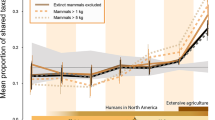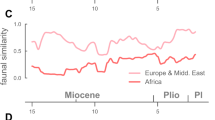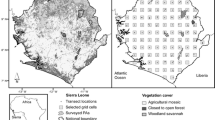Abstract
It is clear that ecosystems are devastated after a volcanic eruption coats the landscape with a layer of ash; however, the ecological recovery of mammalian communities after eruptions is poorly understood. Volcanic eruptions vary with magnitude and type and only a fraction of them have been analysed for effects on mammalian communities. To better understand mammalian community recovery, I investigated how species richness, evenness, and similarity change across volcanic boundaries in the 1980 Mount Saint Helens (MSH), Washington, and 1914–1917 Mount Lassen, California, eruptions. I compared these eruptions to Mount Rainier, Washington and Mount Shasta, California as controls for regional changes in the fauna. Richness and evenness remain relatively unchanged in Lassen. MSH saw an immediate drop in richness, followed by an increase over 5 years to pre-eruptive levels. Chord distance analysis suggests no long-term change in the Lassen fauna. The pre- and post-MSH fauna are different from one another. The post-eruptive fauna was more similar to neighbouring regions. It is clear from my results that larger eruptions tend to have a greater impact on mammalian community recovery than smaller eruptions, but ultimately, mammalian populations are robust and the presence of neighbouring communities is important for recolonizing devastated areas.





Similar content being viewed by others
References
Anderson MJ (2001) A new method for non-parametric multivariate analysis of variance. Austral Ecol 26:32–46. https://doi.org/10.1111/j.1442-9993.2001.01070.pp.x
Barnosky AD, Carrasco MA, Davis EB (2005) The impacts of the species–area relationship on estimates of paleodiversity. PLoS Biol 3:e266. https://doi.org/10.1371/journal.pbio.0030266
Bisson PA, Nielsen JL, Ward JA (1988) Summer production of Coho Salmon stocked in Mount St. Helens streams 3–6 years after the 1980 eruption. Trans Am Fish Soc 117:322–335. https://doi.org/10.1577/1548-8659(1988)117<0322:SPOCSS>2.3.CO;2
Calede JJM, Hopkins SSB, Davis EB (2011) Turnover in burrowing rodents: the roles of competition and habitat change. Palaeogeogr Palaeoclimatol Palaeoecol 311:242–255. https://doi.org/10.1016/j.palaeo.2011.09.002
Chao A, Colwell RK, Lin C, Gotelli NJ (2009) Sufficient sampling for asymptotic minimum species richness estimators. Ecology 90:1125–1133. https://doi.org/10.1890/07-2147.1
Chao A, Gotelli NJ, Hsieh TC, Sander EL, Ma KH, Colwell RK, Ellison AM (2014) Rarefaction and extrapolation with Hill numbers: a framework for sampling and estimation in species diversity studies. Ecol Monogr 84:45–67. https://doi.org/10.1890/13-0133.1
Christiansen RL, Peterson DW (1981) Chronology of the 1980 eruptive activity. In: Lipman PW, Mullineaux DR (eds) The 1980 eruptions of Mount St. Helens, Washington. U.S. Geological Survey Professional Paper, 1250, p 844
Clynne MA, Robinson JE, Nathenson M, Muffler JLP (2012) Volcano hazards assessment for the Lassen Region, Northern California. In: U.S. Geological Survey scientific investigation report 2012-5176-A, p 47
Constable H, Guralnick R, Wieczorek J, Spencer C, Peterson AT, Bart H, Bates J, Cotter G, Hanken J, Moritz C, Simmons N, Trueb L (2010) VertNet: a new model for biodiversity data sharing. PLoS Biol 8:1–4. https://doi.org/10.1371/journal.pbio.1000309
Crisafulli CM, Swanson FJ, Halvorson JJ, Clarkson BD (2015) Volcano ecology: disturbance characteristics and assembly of biotic commu. In: Sigurdsson H, Bruce Houghton B, McNutt S, Rymer H, Stix J (eds) The encyclopedia of volcanoes. Elsevier Inc., Amsterdam, pp 1265–1284. https://doi.org/10.1016/B978-0-12-385938-9.00073-0
Dale VH, Swanson FJ, Crisafulli CM (2005) Disturbance, survival, and succession: understanding ecological responses to the 1980 eruption of Mount St. Helens. In: Dale VH, Swanson FJ, Crisafulli CM (eds) Ecological responses to the 1980 eruption of Mount St. Helens. Springer, New York
del Moral R, Wood DM (1988) Dynamics of herbaceous vegetation recovery on Mount St. Helens, Washington, USA, after a volcanic eruption. Vegetatio 74:11–27. https://doi.org/10.1007/BF00045609
Faith DP, Minchin PR, Belbin L (1987) Compositional dissimilarity as a robust measure of ecological distance. Vegetatio 69:57–68. https://doi.org/10.1007/BF00038687
Franklin JF, Lindenmayer D, MacMahon JA, McKee A, Magnuson J, Perry DA, Waide R, Foster D (2000) Threads of continuity. Conserv Pract 1:8–17. https://doi.org/10.1111/j.1526-4629.2000.tb00155.x
Global Volcanism Program [www document] (2013). https://www.volcano.si.edu/. Accessed 28 Dec 2013
Godron M (1971) Comparison of a species area curve with its model. Oecologia Plant 6:189–196
Grinnell J, Dixon JS, Linsdale JM (1930) Vertebrate natural history of a section of northern California through the Lassen Peak Region. University of California Press, Berkley
Guralnick R, Constable H (2010) VertNet: creating a data-sharing Community. Bioscience 60:258–259. https://doi.org/10.1525/bio.2010.60.4.2
Harris J, Couvering JV (1995) Mock aridity and the paleoecology of volcanically influenced ecosystems. Geology 23:593–596. https://doi.org/10.1130/0091-7613(1995)023%3c0593
Hsieh TC, Ma KH, Chao A (2016) iNEXT: an R package for rarefaction and extrapolation of species diversity (Hill numbers). Methods Ecol Evol 7:1451–1456. https://doi.org/10.1111/2041-210X.12613
Hurlbert SH (1971) The nonconcept of species diversity: a critique and alternative parameters. Ecology 52:577–586. https://doi.org/10.2307/1934145
Kruskal JB (1964) Nonmetric multidimensional scaling: a numerical method. Psychometrika 29:115–129. https://doi.org/10.1007/BF02289565
Louys J (2007) Limited effect of the quaternary’s largest super-eruption (Toba) on land mammals from Southeast Asia. Quat Sci Rev 26:3108–3117. https://doi.org/10.1016/j.quascirev.2007.09.008
Lyman RL (1989) Taphonomy of cervids killed by the May 18, 1980, volcanic eruption of Mount St. Helens, Washington, U.S.A. In: Bonnichsen R, Sorg M (eds) Bone modification. University of Maine Center for the Study of Early Man, Orono, pp 149–167
Marshall CR, Finnegan S, Clites EC, Holroyd PA, Bonuso N, Cortez C, Davis E, Dietl GP, Druckenmiller PS, Eng RC, Garcia C, Estes-Smargiassi K, Hendy A, Hollis KA, Little H, Nesbitt EA, Roopnarine P, Skibinski L, Vendetti J, White LD (2018) Quantifying the dark data in museum fossil collections as palaeontology undergoes a second digital revolution. Biol Lett 14:20180431. https://doi.org/10.1098/rsbl.2018.0431
Oksanen J, Blanchet FGRK, Legendre P, Minchin PR, O’Hara RB, Simpson GL, Solymos P, Stevens MHH, Wagner H (2016) vegan: community ecology package (www document). R Packag. version 2.3-5. https://cran.r-project.org/package=vegan. Accessed 11 Jan 2017
Pielou EC (1966) The measurement of diversity in different types of biological collections. J Theor Biol 13:131–144. https://doi.org/10.1016/0022-5193(66)90013-0
Poole RW (1974) An introduction to quantitative ecology. McGraw-Hill, New York
R Core Team (2015) R: A language and environment for statistical computing, R Foundation for Statistical Computing, Vienna, Austria. https://www.R-project.org/. Accessed 10 Jan 2016
Rosenzweig ML (1995) Species diversity in space and time. Cambridge University Press, New York
Rowe KC, Rowe KMC, Tingley MW, Koo MS, Patton JL, Conroy CJ, Perrine JD, Beissinger SR, Moritz C (2015) Spatially heterogeneous impact of climate change on small mammals of montane California. Proc R Soc B 282:1–10. https://doi.org/10.1098/rspb.2014.1857
Smith B, Wilson JB (1996) A consumer’ s guide to evenness indices. Oikos 76:70–82
Sutton DA, Patterson BD (2000) Geographic variation of the western chipmunks Tamias senex and T. siskiyou, with two new subspecies from California. J Mammal 81:299–316. https://doi.org/10.1644/1545-1542(2000)081<0299:GVOTWC>2.0.CO;2
Williams M (2012) The ~ 73 ka Toba super-eruption and its impact: history of a debate. Quat Int 258:19–29. https://doi.org/10.1016/j.quaint.2011.08.025
Acknowledgements
This research was completed as part of my dissertation at the University of Oregon, and I would like to thank my committee (E. B. Davis, S. S. B Hopkins, J. M. Watkins, S. R. Frost and J. X. Samuels) for their feedback on this manuscript. I would also like to thank J. Bradley (UWBM), C. Conroy (MVZ), C. Fidler (MVZ), H. Garner (TTU), M. Eifler (KU), P. Collins (SBMNH), C. Thompson (UMMZ), J. Esselstyn (LSU), S. Cardiff (LSU), M. Hafner (LSU), C. Dardia (CMVZ), L. Abraczinskas (MSU), B. Coyner (OMNH), G. Shugart (PSM), K. Molina (UCLA), A. Gunderson (UAM), B. Patterson (FMNH), M. Flannery (CAS), Y. Bustos (CAS), and J. Dines (LACM) for assistance and access to collections and records. I also thank C. Cerovski-Darriau, H. R. Dietterich, A. N. Seligman, K. Sweeney, J. D. Orcutt, and W. N. F. McLaughlin for helpful discussions related to this project. The Society of Vertebrate Paleontology Mary R. Dawson Pre-doctoral Fellowship Grant and the University of Oregon Department of Earth Sciences supported this research. I specially thank F. Zachos, two anonymous reviewers, and P. D. Polly for constructive reviews that greatly improved this manuscript.
Author information
Authors and Affiliations
Corresponding author
Additional information
Publisher's Note
Springer Nature remains neutral with regard to jurisdictional claims in published maps and institutional affiliations.
Handling editor: Adriano Martinoli.
Electronic supplementary material
Below is the link to the electronic supplementary material.
Rights and permissions
About this article
Cite this article
Famoso, N.A. Mammalian community response to historic volcanic eruptions. Mamm Biol 100, 219–230 (2020). https://doi.org/10.1007/s42991-020-00022-0
Received:
Accepted:
Published:
Issue Date:
DOI: https://doi.org/10.1007/s42991-020-00022-0




